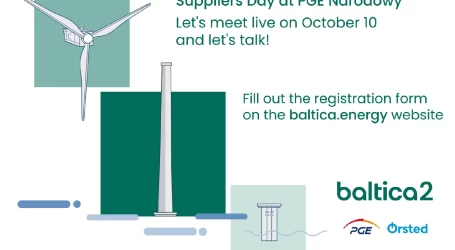Energy from the first wind farms on the Baltic Sea is to flow in 2027

The works on the development plan of maritime areas, which will indicate the locations for wind farms in the Baltic Sea, are being completed. Initial assumptions indicate three regions and an area of over 2,000 km².
The potential of the Polish maritime areas is enormous. If the volume of 10 GW of installed capacity in offshore wind farms, as assumed in the national policy, is achieved, then electricity generation may reach 40 TWh per year. This is about 25% of the total national energy demand. The construction of windmills will be one of the largest infrastructure projects in the country.
– The impatience in the offshore wind energy sector is justified. Since 2010, we all have been waiting for the Polish offshore energy sector to start. We hope that this will be the middle of the next decade. At the turn of 2025/2026 we should see the first projects being built in the Baltic Sea. The government assumes that electricity from these farms will flow in 2027, which may be a little closer. Nevertheless, this decade will certainly be marked by preparations and launch of offshore wind farm projects in Poland,” says Mariusz Witoński, President of the Management Board of the Polish Offshore Wind Energy Association, Newseria Biznes agency.
As he emphasizes, the preparation of offshore wind farm projects is a long-term process which requires complex and extensive environmental research and a long stage of identification of technical conditions for investments in maritime areas.
– In the Polish reality, in fact, it will be a period of about 10 years from the moment of joining the conceptual works until the achievement of the readiness of a given project for the implementation phase, i.e. the construction of the first installations in maritime areas. The construction period of wind farms of such a scale as we expect in the Baltic Sea should close in the perspective of 2-3 years for projects of 400-600 MW,” says Mariusz Witoński.
The locations of the offshore wind farms will indicate the development plan of the maritime areas, on which the works are being completed. – This plan indicates an area of over 2,000 km² for the location of offshore wind farms. These are three regions: located east and north of Słupsk Bank, the eastern slope of Odrzanska Bank and the southern slope of Central Bank. Farms will be located more than 12 nautical miles from the coast, which will allow to protect the landscape values of the Polish coast, while fully exploiting the potential of Polish maritime areas – says the President of the Management Board of the Polish Offshore Wind Energy Association.
If the volume of 10 GW of offshore installed capacity assumed in the national energy policy is achieved, electricity generation may reach 40 TWh per year. This is about 25% of the total demand for electricity on a national scale. This means that in the perspective of the coming years, offshore wind energy will be an important element of the national energy security, ensuring the production of energy from RES.
– We estimate that 8-10 GW of installed capacity will be available in the areas indicated in the draft development plan. This is a huge production potential, considering that the entire Polish power system is slightly more than 40 GW. Therefore, the productivity of offshore wind farms will almost double that of onshore wind farms. We expect that the energy output will be really very high – says Mariusz Witoński.
As he emphasizes, while designing, building and servicing offshore wind farms it is necessary to use the potential of Polish companies – domestic maritime, cable and machine industry, which is already prepared to secure the supply chain for such investments. Many of them have been doing well on export markets for years, supplying components of offshore wind farms to Great Britain, Germany or Denmark.
– How much we will be able to generate green electricity from offshore wind farms will depend directly on the extent to which we will be able to achieve our ambitious investment goals. We have never implemented such projects in Poland. This will be a really huge investment field. Installation activities on the sea and coastal areas will be carried out for a period of 10-15, maybe even 20 years. The scale of these projects seems to be comparable only to the largest infrastructure projects of the interwar period – says Mariusz Witoński.
The challenge will be not only to build wind farms in the Baltic Sea, but also to prepare the power system for receiving the energy they generate. This means the necessity of significant investments on the part of the Polish Power Grids. The schedule of infrastructure investments to be prepared by the Polish transmission system should be coordinated with the schedule of offshore wind farms.
rel. Newseria.pl
Photo: Sławomir Lewandowski



